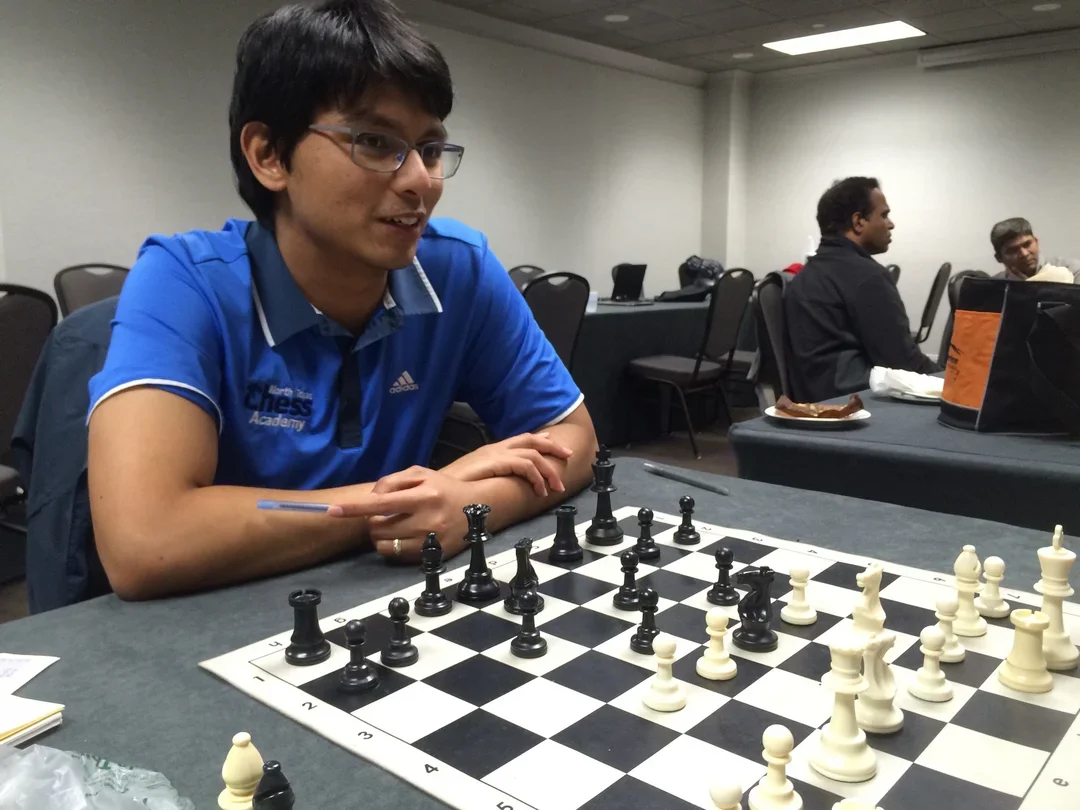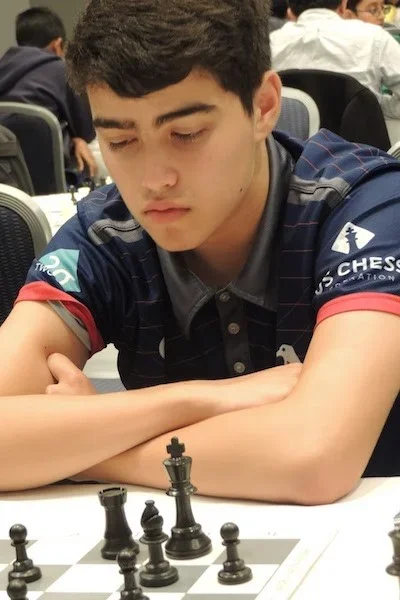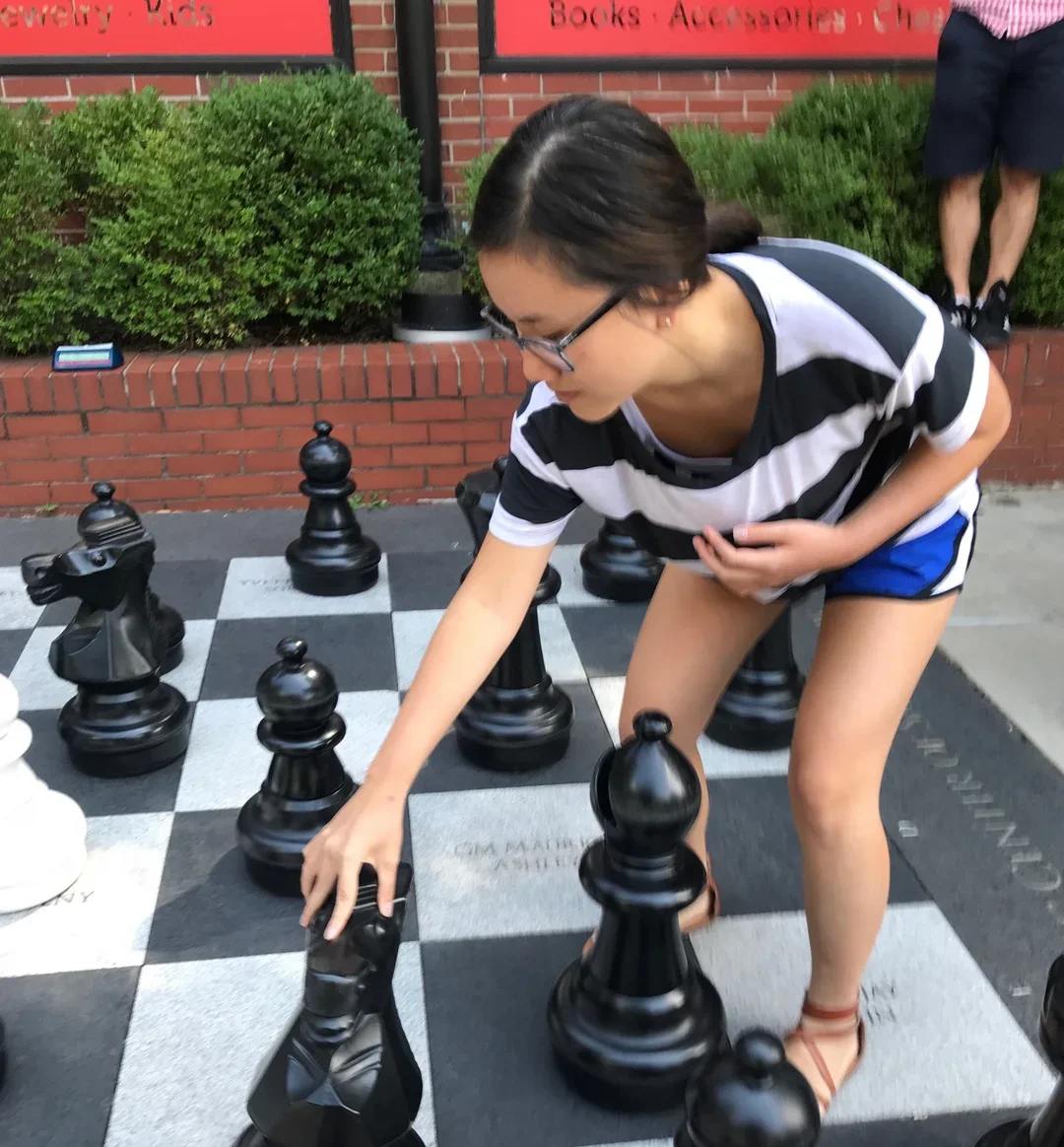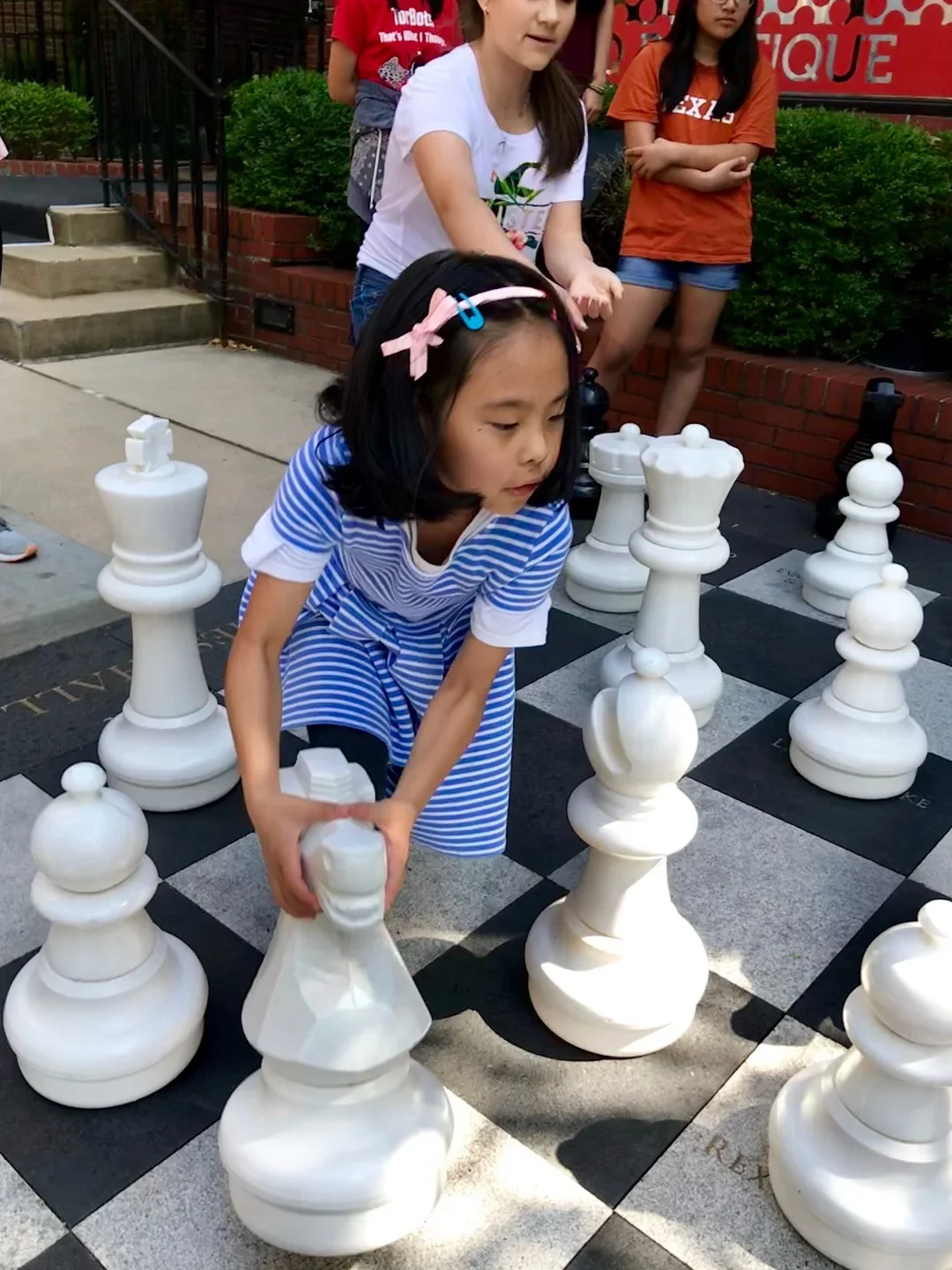The 84th Annual Southwest Open took place on August 30 – September 3 in Irving, Texas. The event attracted 349 players who competed in six sections, two of those in the one-day scholastic event. The International section had 53 players representing 15 federations, including 11 GMs, 14 IMs and one WIM. At the end of the 9-round event, GM Julio Sadorra, GM Jeffery Xiong and IM Cameron Wheeler shared the title with 6.5 points, each earning a third of the top three prizes combined, $2,400-$1,200-$600, so $1,400 for each player.
IM Craig Hilby, a freshman at the University of Texas at Dallas had an outstanding event against very tough competition and earned a GM norm! Hilby explained to US Chess the reason for his surge.
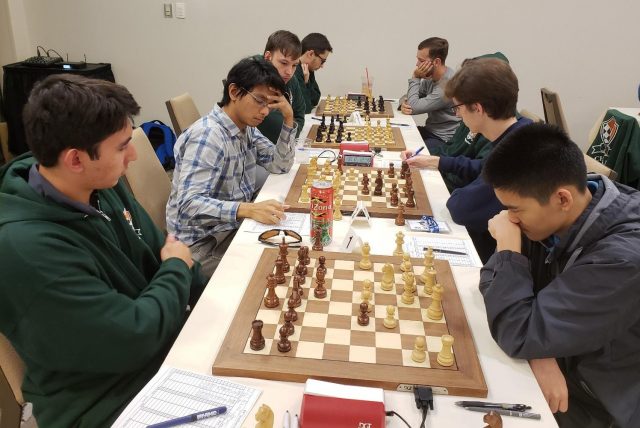 Last round at the Southwest Open: Board 1- Xiong vs Hilby, 2 - Sadorra vs. Checa, 3 - Wheeler vs. Arrivas, 4 – Reshef vs. Matsenko
FM Ben Li and Anish Vivekananthan, with 5.0 points, earned IM norms. For Li, it was his final norm for the title and his IM application will be considered at the upcoming FIDE Congress.
WIM Emily Nguyen, also with 5.0 points, had a strong finish with a win against IM Titas Stremavicious and draws against GM Dani Raznikov and GM Anton Kovalyov to secure a WGM norm.
In the U2300 section, also FIDE rated, WGM Carla Heredia finished in clear first with 6.5/7 and earned the $800 prize. News of her victory spread rapidly throughout the media, as Heredia builds a powerful social media following, which should be of particular interest to our Spanish speaking members, or those who aspire to improve their Spanish.
https://twitter.com/HerediaCarla/status/1037069809089961984
Rachael Li and Shiva Kakarla tied for first, with 6.0 points, in the 7-round Reserve section, each earning $600. This performance allowed the 8-year old Rachael, little sister of GM Ruifeng Li, to increase her rating by 30 points, to 1990, only 10 points shy of achieving an Expert rating! In the 7-round Novice section, Joshua Feldman pocketed the $500 prize as he finished clear first with 6.0 points. His victory allowed him to improve his US Chess rating by 111 points.
The scholastic winners were Kabir Ahmed and Cole Blakeman in the K-12 Championship, and Shreya Kirumaki in the K-12 1000.
The event was organized by Luis Salinas and Barbara Swafford of the Dallas Chess Club. I was the Chief Arbiter/Chief TD and NTD/NA Eddie Rios assisted in the International Section. NTD/IA Brian Yang was the Chief for the U2300, Reserve and Novice Section. The Scholastic Tournament was directed by Louis Reed, Jr. and Thomas Crane. Luis Salinas and Lori Riley were the Pairing Chiefs for all sections except the International.
For US Chess results, please see the tournament's MSA page. The International section results, pairings and FIDE statistics may be found at chessresults. The games of the top 24 boards of the International section were transmitted live using DGT boards, courtesy of UT Dallas, and are available here. For details of this and upcoming events at the Dallas Chess Club, please go to http://dallaschess.com/
Last round at the Southwest Open: Board 1- Xiong vs Hilby, 2 - Sadorra vs. Checa, 3 - Wheeler vs. Arrivas, 4 – Reshef vs. Matsenko
FM Ben Li and Anish Vivekananthan, with 5.0 points, earned IM norms. For Li, it was his final norm for the title and his IM application will be considered at the upcoming FIDE Congress.
WIM Emily Nguyen, also with 5.0 points, had a strong finish with a win against IM Titas Stremavicious and draws against GM Dani Raznikov and GM Anton Kovalyov to secure a WGM norm.
In the U2300 section, also FIDE rated, WGM Carla Heredia finished in clear first with 6.5/7 and earned the $800 prize. News of her victory spread rapidly throughout the media, as Heredia builds a powerful social media following, which should be of particular interest to our Spanish speaking members, or those who aspire to improve their Spanish.
https://twitter.com/HerediaCarla/status/1037069809089961984
Rachael Li and Shiva Kakarla tied for first, with 6.0 points, in the 7-round Reserve section, each earning $600. This performance allowed the 8-year old Rachael, little sister of GM Ruifeng Li, to increase her rating by 30 points, to 1990, only 10 points shy of achieving an Expert rating! In the 7-round Novice section, Joshua Feldman pocketed the $500 prize as he finished clear first with 6.0 points. His victory allowed him to improve his US Chess rating by 111 points.
The scholastic winners were Kabir Ahmed and Cole Blakeman in the K-12 Championship, and Shreya Kirumaki in the K-12 1000.
The event was organized by Luis Salinas and Barbara Swafford of the Dallas Chess Club. I was the Chief Arbiter/Chief TD and NTD/NA Eddie Rios assisted in the International Section. NTD/IA Brian Yang was the Chief for the U2300, Reserve and Novice Section. The Scholastic Tournament was directed by Louis Reed, Jr. and Thomas Crane. Luis Salinas and Lori Riley were the Pairing Chiefs for all sections except the International.
For US Chess results, please see the tournament's MSA page. The International section results, pairings and FIDE statistics may be found at chessresults. The games of the top 24 boards of the International section were transmitted live using DGT boards, courtesy of UT Dallas, and are available here. For details of this and upcoming events at the Dallas Chess Club, please go to http://dallaschess.com/
I was really on form this tournament and was definitely out for blood. My mid-tournament talk with Keaton (Kiewra) really calmed me down and made me forget all about playing for norms or extrinsic purposes; it cleared my head and I played the best chess of my life the last 4 rounds. More and more, I'm taking risks against higher rateds and playing all out for wins when I used to be very happy with a draw.Craig annotated a key victory, his win over GM Kovalyov.
[pgn]
[Event "Southwest Open 2018"]
[Site "?"]
[Date "2018.09.03"]
[White "Kovalyov, Anton"]
[Black "Hilby, Craig"]
[Result "0-1"]
[ECO "D90"]
[WhiteElo "2644"]
[BlackElo "2420"]
[Annotator "9/4/18 Craig Hilby"]
[PlyCount "60"]
[EventDate "2018.??.??"]
[SourceVersionDate "2018.09.04"]
1. c4 {The round scheduling for this tournament was unpleasant, to say the
least. Two days prior, the morning round started at a very relaxing 2:10 PM.
For this round, both of us had to get up and be alert at 9:20 AM... The big
Starbucks bottle and the arizona green tea next to me at the board told the
story of the state of my mental alertness. Luckily, caffeine really does work
and I was able to play some of my best chess later in the game.} Nf6 2. Nf3 g6
3. Nc3 d5 {The pairings for this round were up the previous night, and I
actually cheered internally when I saw I was playing the second seed with
Black. Norms were not a consideration in my mind at the time, and I was just
happy to get the experience of playing an extremely strong grandmaster. I
prepared a little the night before and realized that he was very strong
positionally and strategically, but his mistakes came in more dynamic
positions. Thus, at the board I decided that meeting his Anti-Grunfeld head on
would be a good choice. I was confident in my theoretical knowledge and wasn't
too scared of him preparing anything terribly venomous against me.} 4. cxd5
Nxd5 5. Qb3 Nb6 6. d4 Bg7 7. Bf4 {The main line of the Anti-Grunfeld.} (7. e4 {
in my opinion is actually a more testing move. I think the main line is
actually just good for White} O-O $6 {is the main line} (7... Bg4 {I think is
a better line. The theory here is off-topic, but really interesting for anyone
who wants to study it. There is a line where Black forces White's king from g1
to h6 but it is bad because the king is safe on h6 and White wins...}) 8. Be3
Bg4 (8... Nc6 9. Rd1 Bg4 {transposes}) 9. Rd1 Nc6 {and we enter a short series
of forced moves} 10. d5 Ne5 11. Be2 Nxf3+ 12. gxf3 {There is a small tabiya
here, but I think White is just comfortable whatever Black chooses to play.
I'll give the general lines without revealing too many of my secrets} Bh5 (
12... Bh3 13. Rg1 $1 Qc8 14. f4 $16) (12... Bd7 13. h4 $1 $40) 13. Rg1 Qd7 (
13... Qc8 14. Rg3 c6 15. a4 $5 $14) 14. Rg3 c6 (14... f5 $6 15. d6+ $1 Kh8 16.
dxc7 Qxc7 17. Nb5 Qb8 18. exf5 Rxf5 19. Nd4 Rd5 20. Ne6 $14) 15. dxc6 Qxc6 16.
Nb5 Rfc8 17. a3 $1 $14) 7... Be6 8. Qa3 c5 {For the amount of theory in this
line, there are surprisingly not that many games.} (8... Nc6 {is the main move,
and is a completely different line}) 9. Qxc5 (9. e4 cxd4 10. Nb5 O-O 11. Nc7 {
Navara-Wei Yi is the key game to look at for this line.}) 9... Nc6 10. e4 (10.
e3 {had been played against me before by Guillermo Vazquez, and I would have
been ready for this move had it been played again against me.} Rc8 11. Qa3 O-O
12. Be2 (12. Rd1 a5 $1 13. Ne5 Nb4 14. Qxa5 Nc2+ 15. Kd2 Nxd4 $1 {ends up
working out for Black}) 12... Nc4 13. Qa4 Nxb2 14. Qb5 {and Black can choose
between 14...Nc4 and 14...Qb6, both of which I believe equalize.}) 10... Rc8 {
This leads to some pretty crazy lines, one of which was played in the game} (
10... Nxd4 $6 11. Nxd4 Bxd4 12. Bb5+ Kf8 13. Qa3 a6 14. Be2 $14 {In addition
to not being a lot of fun, Black is probably also objectively worse here.}) (
10... Nd7 11. Qa3 Nxd4 12. Nxd4 Bxd4 13. Bb5 Rc8 14. Rd1 {is more pleasant for
White to play}) 11. Qa3 (11. d5 $2 {is impossible due to} Nd4 $1 {winning the
queen}) 11... Nxd4 12. O-O-O O-O 13. e5 {Following the main line of this
variation} (13. Nxd4 Bxd4 14. Kb1 {One of the main justifications for this
being playable for Black is that he can play} Bc5 $1 (14... Nc4 {would just be
bad due to} 15. Bxc4 Bxc4 16. Be5) 15. Rxd8 Bxa3 16. Rxf8+ Kxf8 $11) (13. Be3 {
is another variation, and Black should play} Nc4 14. Bxc4 Rxc4 15. Nxd4 (15.
Kb1 Bg4 $1 16. Nd5 e5 $1) 15... Bxd4 16. Bxd4 Rxd4 17. Qxa7 b6 $1 {with good
compensation}) 13... Nc4 14. Qxa7 (14. Bxc4 Rxc4 $15 {would be very good for
me. Black has no problems at all}) 14... Qc7 $1 15. Rxd4 (15. Nxd4 {Actually
leads by force to an equal endgame after} Nxb2 16. Ndb5 Nxd1 17. Nxc7 Nxc3 18.
Nxe6 Nb5+ (18... fxe6 $5 $13 {is a very interesting try}) 19. Kb1 Nxa7 20. Nxf8
Kxf8 $11) 15... Ra8 16. Rxc4 Bxc4 17. Qe3 Bxa2 18. Kc2 {This is actually the
first move out of my theoretical knowledge, so I took some time here to
understand the position. What is going on? Material wise, Black is down a rook
for two knights. Black's compensation comes in the form of an initiative on
the White king. This means that every move I make has to, in some way or form,
increase the pressure on White's king or else my initiative will fade and I
will simply be worse. My next few moves should be about improving my major
pieces to the squares where they can best put pressure on the White king.} (18.
Bd3 $1 {was a better move} Rfd8 (18... Rfc8 $2 19. Kd2 $1 $16) 19. Bb1 Bxb1 20.
Kxb1 Qa5 {is as far as my theoretical knowledge went. It seems that White
might try for an advantage here with} 21. Rc1 {but Black has counterplay with}
b5 $13) 18... Rfc8 $6 {This is stupid for a very simple reason: I know for
sure that my queen wants to go to a5, but I don't know whether I want my rook
on d8 or c8. Therefore, I should have gone Qa5 first and only later decide
where my rook belongs.} (18... Qa5 19. Bd3 Rfd8 $1 {In this position, the rook
is better placed on d8} 20. Rd1 (20. Ra1 $2 Bb3+ $1) 20... Qb4 $36) 19. Nd4 (
19. Bd3 $1 {would have been better, though this is a bit illogical in
conjunction with Kc2} Qa5 20. Rc1 {and here my best move is to move my rook
back to d8} Rd8 {White has several moves at his disposal that look decent,
such as Qe4 or Nxa2}) 19... Qa5 20. Bd3 $2 {This move didn't really make sense
at all to me during the game. I want to go Qa4+, so why not stop it with Bb5?}
(20. Bb5 {I was planning to play} Bc4 (20... Qb4 21. Ra1 $14) 21. Bxc4 Rxc4 {
and start piling on the pressure with b5 next move}) 20... Qa4+ $1 {My queen
belongs on b4, but I might as well misplace White's king before going there.}
21. Kc1 Qb4 22. Be4 {At this point, I took my longest think in the game (about
40 minutes). I have several candidate moves here, and I thoroughly checked:
Ra3, Rc4, Ra4, f6, Bb3, and Bd5. I am extremely proud of the decision I made
in the game to play Bd5} (22. Rd1 {is the best move according to the engine,
but I have a raging initiative after} Bb3 (22... Bd5 $5) 23. Bc2 Ra1+ 24. Kd2
Rxd1+ 25. Kxd1 Rd8 $40) 22... Bd5 $1 {White's pieces are loose and
uncoordinated, and this move takes full advantage.} (22... Ra3 $5 {was the
candidate move that I looked at the longest} 23. Qd2 (23. Nc6 $2 Rxc3+ 24. Qxc3
(24. bxc3 Qa3+ 25. Kd1 bxc6 $17) 24... Rxc6 $1 25. Bxc6 Qxf4+ $19) (23. bxa3 $2
Rxc3+ 24. Nc2 (24. Kd1 Qa4+ $19) 24... Qxa3+ $1 25. Kd2 Rxe3 26. Nxa3 Rxe4 $19)
23... Raxc3+ (23... Rb3 $1 {is a good move that I actually completely
overlooked. Black threatens both Rxb2 and Rcxc3+} 24. Nxb3 (24. Re1 Rxb2 (24...
Rcxc3+ $6 25. bxc3 Rb1+ 26. Kc2 Rb2+ 27. Kc1 Rb1+ $11) 25. Qxb2 Rxc3+ 26. Bc2 (
26. Nc2 Rxc2+ $1 27. Kxc2 Qxe1 $17) 26... Rxc2+ $1 27. Nxc2 Qxf4+ 28. Ne3 Be6
$40 {Despite being down an exchange, Black has a huge initiative against
White's bare king. In a practical game, I would take Black's position in a
heartbeat.}) 24... Qxe4 {Black threatens both Bxb3 and Qb1#!} 25. Qd8+ $1 Rxd8
26. Nxe4 Bxb3 27. Nc3 h6 $15 {Black has a pleasant endgame}) 24. bxc3 Rxc3+ 25.
Kd1 Rc4 $1 26. Be3 (26. Qxb4 Rxb4 27. Ke2 (27. Be3 Bxe5 $17) 27... Rxd4 28. Ke3
Rb4 $15) 26... Bxe5 27. Bd5 Rxd4 28. Bxd4 Qb1+ (28... Qa4+ 29. Kc1 Qa3+ 30. Kd1
Qa4+ $11) 29. Qc1 Qd3+ 30. Qd2 {and Black only has a draw. I saw this at the
board but wanted more}) (22... Rc4 $2 {is critical, but doesn't work at all.
White is actually better after Rd1.} 23. Rd1 Rd8 (23... Bb3 24. Nxb3 Qxb3 25.
Rd4 $1 $16) 24. Nc2 $1 Rxd1+ 25. Nxd1 Bb3 26. Nc3 $16) (22... Ra4 {is the same
as Rc4 more or less} 23. Rd1 Bb3 24. Nxb3 Qxb3 25. Rd4 Ra1+ 26. Bb1 $14) (22...
f6 {Looks weird intuitively, but I found it hard to refute so I had to look at
it. I came up with} 23. Re1 $1 (23. Nc2 Rxc3 $1) 23... fxe5 24. Nc2 $1 Rxc3 $1
{I completely overlooked this move though, and I end up with a slightly better
endgame} (24... exf4 {is the line I saw} 25. Nxb4 fxe3 26. Nbxa2 exf2 (26...
Rxa2 $2 27. Bd5+ $1) 27. Rf1 {If I had calculated that Bd5 didn't work out,
this is the position I actually would have aimed for.} Rf8 $13) 25. Qxc3 Qxc3
26. bxc3 exf4 27. Bxb7 Rd8 $15) (22... Bb3 {forces White to play} 23. Nxb3 Qxb3
24. Kb1 $1 {0.00/0 but for the life of me, I couldn't find anything for Black
here. Indeed, the engine just shows zeroes} (24. Rd1 $2 Ra1+ 25. Bb1 b5 $19 {
is crushing})) 23. Bxd5 {White does not really have a more appealing option.
He has to go for this and hope that his minor pieces have enough activity to
compensate for his weak king.} (23. Nc2 {would win were it not for} Rxc3 $1 {
which is absolutely essential to see} 24. bxc3 (24. Qxc3 $2 Qxe4 $19) 24...
Qxe4 25. Qxe4 Bxe4 $15 {Black is much better in this endgame}) 23... Ra1+ 24.
Kc2 Rxh1 25. Bg3 $2 {This is the decisive mistake of the game. Curiously, my
opponent did not actually spend very long in making it. I am actually still
not so sure what the point behind it is.} (25. Nb3 $2 {is what I had expected,
and I was planning to play} e6 26. Bf3 b5 $1 $17) (25. g3 $1 {was the best
move, and just leads to wildly unclear positions} Rf1 $1 (25... Rxh2 26. Nf3
Rh5 (26... Rh1 $2 27. Ng5 $40) 27. Ng5 (27. g4 Rh3 28. Bxf7+ Kh8 (28... Kxf7 $2
29. Ng5+ Kg8 30. Nxh3 Qa4+ 31. Kb1 $14) 29. Bd5 b5 {Black has the initiative})
27... Rxg5 28. Bxg5 e6 29. Bb3 $13 {The engine still shows zeros, but I think
White is more comfortable here in a practical game because Black's attack has
fizzled out}) (25... Ra1 26. Nb3 Ra4 {is another strange engine recommendation.
.. I am not exactly sure what the rook even does on a4 though.}) 26. Nb3 (26.
h4 $5 e6 (26... h6 $1 {White is actually kind of stuck. He can't really do so
much}) 27. Nxe6 (27. Bb3 $6 Qa5 $40) 27... Qa4+ $1 28. Bb3 Qa1 {And everything
just starts going nuts} 29. Nc5 b6 30. e6 {The engine recommends h5 as one of
the top moves here, so honestly I'm just going to stop the variations and
conclude that the position remains wildly unclear.}) 26... e6 27. Bg2 Rg1 28.
Bf3 b5 $13 {Objectively it is equal, but I would prefer Black here just
because at least I have a vague plan of b5-b4 and attacking White's king,
whereas White kind of just has to respond to whatever Black does.}) 25... Qa4+
$1 26. Nb3 $2 {Losing on the spot} (26. Kd3 {had to be played, for better or
worse} Qa1 {but Black's position is winning after} 27. Qd2 (27. Bb3 Qxb2 28.
Qd2 Qa1 $19) 27... b5 $1 (27... e6 {The less flashy method also works
perfectly fine} 28. Bb3 Rd8 $19) 28. Ke3 (28. Ncxb5 Rd1) (28. Ndxb5 Rd8 $19)
28... b4 29. Nce2 Rb1 $19) (26. Bb3 Qa1 27. Kd3 {transposes into 26.Kd3}) 26...
Qa2 {threatening Qb1+} 27. Nc5 Qa5 $1 {I think this is the move that my
opponent missed when he played Bg3. Instead of going Qa1, I can go Qa5 to
skewer the White knight and bishop. Surprisingly, there is nothing White can
do to avoid just losing on the spot.} 28. b4 {Basically sealing his
resignation. Obviously, White cannot survive the attack without his b-pawn} (
28. Qf3 Qxc5 29. Qxf7+ Kh8 $19 {doesn't harm me at all. My king is perfectly
safe}) (28. Bxf7+ Kxf7 $19) 28... Qxb4 29. Nb3 (29. N5e4 Qb1+ (29... e6 30. Bb3
b5 $19) 30. Kd2 Qb2+ 31. Kd3 e6 $19) 29... e6 30. Bf3 {My opponent resigned as
I hovered my hand over my h1 rook to play} Rb1 $1 0-1
[/pgn]
Craig also thanked his coach and family.
My coach Alexander Ipatov has been an amazing inspiration and help in my growth throughout this last year, he is the one who taught me the Grunfeld that served me so well this tournament. He helped transform me into a much better player. My parents have also been amazingly supportive of me throughout my chess career.
 Last round at the Southwest Open: Board 1- Xiong vs Hilby, 2 - Sadorra vs. Checa, 3 - Wheeler vs. Arrivas, 4 – Reshef vs. Matsenko
Last round at the Southwest Open: Board 1- Xiong vs Hilby, 2 - Sadorra vs. Checa, 3 - Wheeler vs. Arrivas, 4 – Reshef vs. Matsenko Categories
Archives
- December 2025 (18)
- November 2025 (29)
- October 2025 (39)
- September 2025 (27)
- August 2025 (29)
- July 2025 (43)
- June 2025 (25)
- May 2025 (24)
- April 2025 (29)
- March 2025 (29)
- February 2025 (20)
- January 2025 (24)
- December 2024 (34)
- November 2024 (18)
- October 2024 (35)
- September 2024 (23)
- August 2024 (27)
- July 2024 (44)
- June 2024 (27)
- May 2024 (31)
- April 2024 (51)
- March 2024 (34)
- February 2024 (25)
- January 2024 (26)
- December 2023 (29)
- November 2023 (26)
- October 2023 (37)
- September 2023 (27)
- August 2023 (37)
- July 2023 (47)
- June 2023 (33)
- May 2023 (37)
- April 2023 (45)
- March 2023 (37)
- February 2023 (28)
- January 2023 (31)
- December 2022 (23)
- November 2022 (32)
- October 2022 (31)
- September 2022 (19)
- August 2022 (39)
- July 2022 (32)
- June 2022 (35)
- May 2022 (21)
- April 2022 (31)
- March 2022 (33)
- February 2022 (21)
- January 2022 (27)
- December 2021 (36)
- November 2021 (34)
- October 2021 (25)
- September 2021 (25)
- August 2021 (41)
- July 2021 (36)
- June 2021 (29)
- May 2021 (29)
- April 2021 (31)
- March 2021 (33)
- February 2021 (28)
- January 2021 (29)
- December 2020 (38)
- November 2020 (40)
- October 2020 (41)
- September 2020 (35)
- August 2020 (38)
- July 2020 (36)
- June 2020 (46)
- May 2020 (42)
- April 2020 (37)
- March 2020 (60)
- February 2020 (38)
- January 2020 (45)
- December 2019 (34)
- November 2019 (35)
- October 2019 (42)
- September 2019 (45)
- August 2019 (56)
- July 2019 (44)
- June 2019 (35)
- May 2019 (40)
- April 2019 (48)
- March 2019 (61)
- February 2019 (39)
- January 2019 (30)
- December 2018 (29)
- November 2018 (51)
- October 2018 (45)
- September 2018 (29)
- August 2018 (49)
- July 2018 (35)
- June 2018 (31)
- May 2018 (39)
- April 2018 (31)
- March 2018 (26)
- February 2018 (33)
- January 2018 (30)
- December 2017 (26)
- November 2017 (24)
- October 2017 (30)
- September 2017 (30)
- August 2017 (31)
- July 2017 (28)
- June 2017 (32)
- May 2017 (26)
- April 2017 (37)
- March 2017 (28)
- February 2017 (30)
- January 2017 (27)
- December 2016 (29)
- November 2016 (24)
- October 2016 (32)
- September 2016 (31)
- August 2016 (27)
- July 2016 (24)
- June 2016 (26)
- May 2016 (19)
- April 2016 (30)
- March 2016 (36)
- February 2016 (28)
- January 2016 (32)
- December 2015 (26)
- November 2015 (23)
- October 2015 (16)
- September 2015 (28)
- August 2015 (28)
- July 2015 (6)
- June 2015 (1)
- May 2015 (2)
- April 2015 (1)
- February 2015 (3)
- January 2015 (1)
- December 2014 (1)
- July 2010 (1)
- October 1991 (1)
- August 1989 (1)
- January 1988 (1)
- December 1983 (1)



